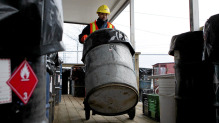Stewardship Ontario headed for fee overhaul
 Ontario’s Environment Minister announced sweeping changes on Thursday to the way the body that oversees most recycling in the province funds its hazardous waste program. He also ordered a review of Stewardship Ontario’s finances and its newly-established incentive pricing program.
Ontario’s Environment Minister announced sweeping changes on Thursday to the way the body that oversees most recycling in the province funds its hazardous waste program. He also ordered a review of Stewardship Ontario’s finances and its newly-established incentive pricing program.Stewardship Ontario reports to provincially mandated Waste Diversion Ontario and collects fees from producers of hazardous materials such as paints and batteries and uses them to pay for recycling.
It came under fire in 2010 with the unsuccessful introduction of ‘eco-fees,’ and last fall, an announcement that it would overhaul its pricing plan for haulers and recyclers of hazardous materials set the industry reeling and prompted several companies to accuse the body of market manipulation.
Some municipalities also told the Globe and Mail that Stewardship Ontario is not fully covering the costs of its hazardous waste recycling programs, prompting at least one, Niagara Region, to consider cutting back in recycling services to the public.
Until recently, municipalities in Ontario were responsible for setting up contracts with hauling and recycling companies, then submitted their bills to Stewardship Ontario.
In the fall, Stewardship Ontario announced it would take contracting out of the hands of municipalities and instead pay recycling companies a fixed fee for their work. At least two companies announced they would pull their services, saying the predetermined fee was too low for them to make any money.
The change also cast an unfavourable light on municipalities, as comments from Stewardship Ontario suggested it didn’t trust the tendering process by municipalities to procure recycling services in an open and transparent manner.
The province announced Thursday that it will direct Waste Diversion Ontario to review the new pricing plan, with a view to determine whether it was interfering in the province’s marketplace unfairly.
The minister will also require Stewardship Ontario to collect fees at the end of each quarter, based on the actual costs of recycling materials instead of a projected cost estimated at the beginning of each fiscal year.
Recycling advocates have long worried that basing fees to the industry on prior estimates encouraged Stewardship Ontario to meet its recycling targets – but not to surpass them.
“I think the best way to do it that I can see going forward is to get away from the projections on a per unit basis and simply say this is what the cost was,” Environment Minister Jim Bradley told the Globe and Mail.
“That’s probably a much fairer system and I think it will take a lot of the guess work out of it.”
Mr. Bradley added he wants to see a membership overhaul of Waste Diversion Ontario’s board, which oversees Stewardship Ontario’s operations.
“We want to get a board that’s based on skills as opposed to those that simply have interests in the field,” Mr. Bradley said.
Waste Diversion Ontario CEO Michael Scott said he welcomed the changes to the board’s structure, adding it’s something his organization had asked for before the last provincial election.
Mr. Bradley said the new board would be charged with conducting a detailed review of Stewardship Ontario’s budget and expenditures as well as its efficacy in diverting waste from landfills and incinerators.
Sue McCrae, chair of the Municipal Waste Association, which represents municipal waste departments across Ontario, said the announcement is good news for both municipalities and consumers.
“The problem has been that paying for the management of these waste materials has been tacked on to the municipal tax base. Now it will go back to producers,” s
You can return to the main Market News page, or press the Back button on your browser.

